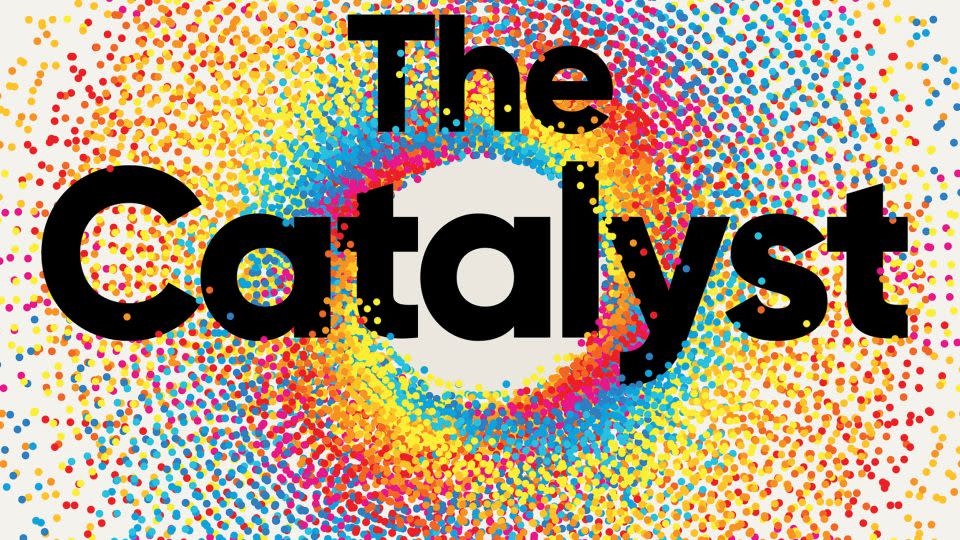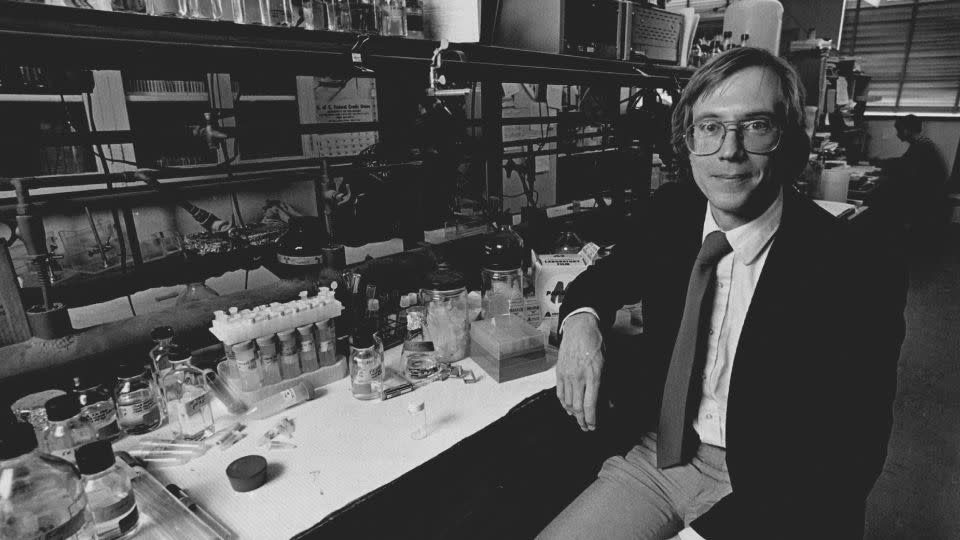While you’re probably pretty familiar with DNA, it’s likely that RNA only came onto your radar during the pandemic, thanks to the Covid-19 vaccines produced by Moderna and Pfizer.
Chemist Thomas R. Cech says DNA is a “repository of genetic information.” It contains genes that code for all the proteins a living thing needs, that enable our muscles to move or our heart to beat, or that form the circuits in our brain. “Proteins are the key to life, and DNA tells the body how to make each of these, but it doesn’t do it directly, it has an intermediary messenger.”
This is where RNA comes into play. As a messenger, it carries the instructions from our DNA to the region where the protein is created.
“We have seen with mRNA (messenger RNA) vaccines that this can be a good reporter,” Cech says. “But it can do much more than just act as a message.”
Cech would know. In 1989, he and Sidney Altman won the Nobel Prize in Chemistry for their discovery that RNA “can function not only as a molecule of inheritance but also as a biocatalyst,” or enzyme (basically a type of spark that can facilitate a chemical reaction). .
Cech researched RNA for many years and taught chemistry to undergraduate students at the University of Colorado at Boulder. Now, he has published a book titled “Catalyst: RNA and the Quest to Unlock Life’s Deepest Secrets” to share his knowledge with everyone and what it could mean for the future.
This interview has been edited for length and clarity.

In “Catalyst” you stated that research on RNA has been carried out since the 50s. Now why did you decide to write a book on this subject?
Although scientists have been aware of the wonders of RNA for over half a century, the general public is really focused on DNA.
This is understandable, because DNA allows us to understand whether our family carries a genetic disease, allows us to trace our ancestors, and solves crimes. In fact, if something is truly fundamental to us, we use phrases like “It’s in our DNA.” So everyone is comfortable with DNA.
However, RNA, which some of us thought was much more versatile and interesting, was actually only of interest to scientists. And I thought the non-scientist population might be interested in hearing about it.
What do most people misunderstand about mRNA vaccines like Covid-19 vaccines?
They were developed so quickly that people were understandably skeptical, perhaps because some caution had been taken and this was a newly released drug they should have been suspicious of.
But we have actually understood how mRNA works in great detail since the 1960s. It is present in every living organism on earth. It is found in all the foods we eat, regardless of whether we are vegetarians or meat lovers. So mRNA is not a strange drug. Actually, it is a very natural molecule. In Boulder, Colorado, we might even say it’s organic.
All the technologies needed to make the vaccine have been meticulously developed, proven and understood by scientists for decades.
When the brave scientist in China put pieces of the so-called sequence of the SARS-CoV-2 genome (the virus that causes Covid-19) online, it is an RNA, by the way… The virus does not even mix with the DNA at all. It’s just an RNA virus because RNA, like DNA, can store information – it took scientists only weeks to determine what the protein on the outside of the virus should be – that would be the first thing our immune system would see – and, therefore, to the human body to alert our immune system and make it alert to the virus. The protein we need to give.
How might mRNA impact future health crises?
We are in this fascinating moment in time where opportunities seem almost limitless, but we don’t know how many of them will materialize. So we have all the ideas but we don’t know which one will be practical.
So let me start with the low hanging fruit that could be other vaccines. I think, given the success rate of the Covid-19 vaccine (although respiratory viruses are terrible tar, it’s really hard for any vaccine technology to be very good), mRNA vaccines for other viruses could work much better.
What we’re looking forward to is the opportunity for a flu vaccine that might work against all strains, rather than the strain we think will dominate next flu season.
So flu vaccines, as we all know, are pretty marginal. Depending on the year they may be 60% effective, they may only be 40%. Still, it’s worth getting the injection. But you know, it’s kind of like 50/50, it’s going to really help you.
If we can use mRNA vaccines to speed up this process, or even produce vaccines against more than one strain, we can greatly increase the value of the vaccine.
There is also an even more speculative area related to genetic diseases in which we are missing a protein we need for a healthy life. Cystic fibrosis is a genetic disease, we know which protein is missing but we don’t know how to put it back. Muscular dystrophy, we know what protein is missing in these kids’ muscles, we don’t know how to put it back. Could mRNA be the code that will replace this protein? Theoretically yes. Practically speaking, we don’t know if we can produce enough of the protein in the right tissue to be therapeutic. But it’s exciting enough that scientists are working on it.
In the book, you mention that more than 400 RNA-based drugs are in development. Can you talk about this?
Because RNA is so central to biology, if there is an RNA that causes disease, we may want to cleave it or otherwise neutralize it. There are multiple categories of these, but one of the fascinating ones—and this is a chapter in the book—are small interfering RNAs. These are again natural products.
We can repurpose this compound to attack disease-causing RNAs in our cells. And this is the work of a company called Alnylam in Cambridge, Massachusetts, and they’ve now got five of these drugs approved, and they’re against rare diseases.
That’s the beauty of this job. RNA technology is so fast for repurposing to a new disease that you don’t need to just target diseases that have a very large patient population – where you can recoup the huge cost of drug development by selling the drug – you can actually target fairly rare diseases and have a real impact on that patient population. Make an impact.


How does CRISPR affect all this?
CRISPR technology is a way to correct errors in our DNA that occur in our chromosomes. And this little machine that moves around the body has two components. It has a protein that resembles small scissors that can cut DNA and make corrections to the DNA code.
Many human diseases are genetic or have a genetic component. An example of this is sickle cell anemia, an incredibly painful and debilitating blood disease caused by a single change in the gene for the blood-carrying protein hemoglobin.
Just a few months ago, a CRISPR-based therapy for sickle cell (the first therapy) was approved for use in the United States. And we will see more of these.
The real secret sauce here is RNA. RNA is the component that allows the CRISPR machine to be so specific and edit one gene in the human genome while leaving all other genes intact.
What are some potential uses of CRISPR that people haven’t even thought about?
The other big opportunity relates to the plants and animals we rely on for food and shelter. They’re under stress because the planet is warming, and so are the oceans.
We get about one-third of the world’s protein from the marine environment. The bleaching of coral reefs, which form a large part of the marine ecosystem, will pose a real challenge to the food production of fish, shellfish and other marine organisms in the future.
So what can CRISPR do? Let’s use coral as an example. Coral has no real biology; It’s a hard-shelled thing. Compared to research on mice, humans, and other organisms with backbones, almost no one studies corals.
Now, with CRISPR, we can actually modify the coral genome and do what it takes hundreds of years of evolution in nature to allow corals to adapt to rising sea temperatures. We can do this fairly quickly and reintroduce heat-tolerant corals into the oceans.
Scientists talk about the ethics of what we can and should do. The public has also been thinking more lately about how ethical it is to change some of these things, i.e. edit our DNA. How does this apply to DNA, RNA, mRNA, and CRISPR?
I think we need to start explaining these things. So we need to start with schools, but also other places where people gather—churches, Rotary Clubs, Lions Clubs, book clubs, and other venues—and engage the public.
But in the meantime, scientists are meeting and talking about the ethical implications of this. And one of the things they decided was that it was too early to allow CRISPR genome editing of the human germline so that the changes could be inherited.
You may ask: “Well, why wouldn’t you want to do it if you can? Is it possible to cure sickle cell disease in a patient? Why don’t you want to change the legacy of this and eliminate it completely?”
There may come a time when we are ready to do this. However, we do not currently know 100% the security of this technology; In addition to changing the code of the target gene we are trying to fix, the brain may inadvertently make other changes here and there. human genome.
Another concern is what is called development; Can this technology be used to raise your children, strengthen them, choose their hair color and eye color, and give them other characteristics that will make them a superior race? And we think, wow, this sounds a lot like Nazi Germany – a lot like eugenics. And we don’t think that’s an appropriate use of this technology. But we need to discuss this.
You had to remove some things from the book for the sake of brevity. Is there anything you couldn’t add that you wanted people to know?
One fascinating area involves evolving RNAs in the laboratory to do new things that natural RNAs don’t do. You can make RNAs that do extraordinary things that you’ve never seen in nature, that could be intellectually exciting or really useful for technology. This is an area that I talked about very briefly because I wanted to get the book out.
What are some practical uses for evolving RNAs in laboratories?
I think it may have medical uses. Of course, most of this was happening before CRISPR and gene editing. Now that we have CRISPR, that’s a pretty high bar for doing better than that. Some can be used as biosensors, so RNA can be engineered to glow when it sees a particular toxic compound. Could such RNAs be found in our water system against new coronaviruses? I think again the answer is yes. We probably have the technology to do this. Is it practical? Is it cheap? Is this enough to use in a broad sense? Now these are the challenges with these things.
For more CNN news and newsletters, create an account at CNN.com